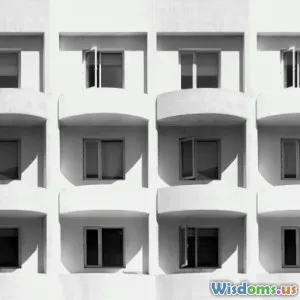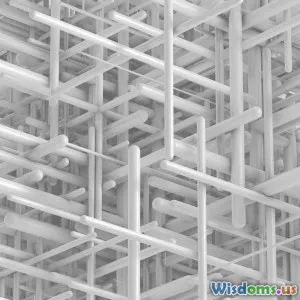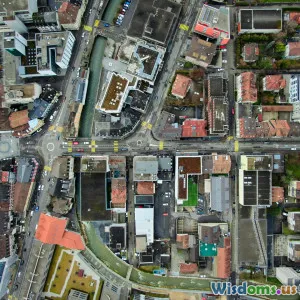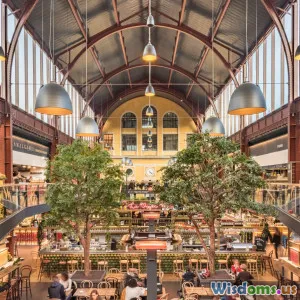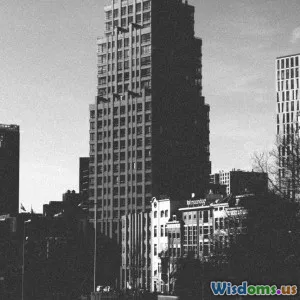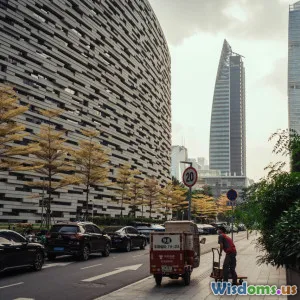
Innovation Versus Tradition the Concrete Dilemma in Urban Design
12 min read Explore the intricate balance between innovative methods and traditional wisdom in urban design, and how concrete shapes the future and identity of our cities. (0 Reviews)
Innovation Versus Tradition: The Concrete Dilemma in Urban Design
Urban design is the silent sculptor of our daily experience—a force shaping not just skylines, but also culture and community. Modern cities are battlegrounds where the gleaming promise of innovation wrestles with the resilient roots of tradition. Concrete, both literally and figuratively, lies at the heart of this duel.
Are the shimmering towers of tomorrow sacrificing the soul of yesterday? Can we build the future without bulldozing our past? This article dives deep into the dynamic tension between innovation and tradition in urban design, with a particular focus on the very material upon which cities stand—concrete.
The Stage: Urban Design as a Living Narrative
Cities aren’t just accumulations of buildings or roadways; they are narratives written in stone, wood, glass, and concrete. Urban design encompasses everything from imposing public spaces and intimate alleyways to transportation infrastructure and the cultural celebration embedded in public squares.
Here, tradition and innovation play vital parts. As the English architectural theorist Sir Peter Cook puts it: “Cities are not mere objects for utility, but organic, evolving entities with embedded collective memory.”
The question isn’t just “how do we build?” but “how do we remember while we create?” This becomes even more crucial as global urbanization accelerates, with 68% of the world’s population projected to live in urban areas by 2050 (UN, 2018).
Concrete: The Backbone and Controversy
Concrete traces its history back to the ancient Romans, but it’s the go-to material of the modern world. According to the Global Cement and Concrete Association, over 30 billion tons of concrete are consumed annually—more than any other manufactured material on the planet.
Concrete as Innovation
-
Mid-20th Century Modernism: Just after WWII, concrete promised speed, affordability, and versatility. Cities like São Paulo and London soared upwards with concrete megastructures—schools, hospitals, housing blocks—many inspired by Le Corbusier’s ‘Radiant City’ ideal.
-
Contemporary Marvels: Modern wonders like Zaha Hadid’s MAXXI Museum in Rome or the elevated High Line Park in New York use concrete as both structure and sculpture. Each innovation aims to solve problems—density, cost, sustainability—while expressing 21st-century creativity.
Concrete as Culprit
Yet, concrete’s ubiquity is also its curse. Impersonal slabs can alienate, block human connection, and erase local character:
- In postwar Britain, the rapid rise of “Brutalist” architecture led to immense housing estates. Many, such as Sheffield’s Park Hill, became synonymous with social problems.
- In China, rapid modernization has replaced traditional hutongs with featureless high-rises, raising questions about erased heritage.
Concrete innovation and tradition aren’t just architectural styles—they are lived realities.
Section 1: Why Does Tradition Matter?
Urban tradition is more than nostalgia. Spaces convey memory, belonging, and social meaning. Historic cityscapes like Kyoto, Prague, or Rome blend physical beauty with persistent cultural identity, welcoming both residents and visitors.
- Place Identity: Kevin Lynch, in "The Image of the City," described how traditional urban forms—narrow streets, squares, ornate façades—aid in orientation and instill identity.
- Social Sustainability: Traditional environments foster informal networks and public rituals; Barcelona’s Gothic Quarter, with its labyrinth of old alleys, supports communal interaction that new districts struggle to emulate.
“Without memory there is no culture. Without memory, there would be no civilization, no society, no future.” — Elie Wiesel
Case Study: Venice
Venice’s built form resists conventional modernization. Innovation is subtle—installation of discrete fiber-optic infrastructure, lagoon floodgates —because the political and cultural resistance to altering centuries-old architecture is strong. Still, innovation is required to preserve tradition in a city literally sinking under its own weight (and tourist numbers).
Section 2: The Drive for Innovation
Why depart from tradition?
Urban Challenges Demand New Solutions
Contemporary urban environments confront issues that traditional patterns can't always resolve:
- Population Surge: By 2050, cities like Lagos and Jakarta will dwarf their current populations. Traditional low-density housing can't accommodate such growth.
- Resource Scarcity & Environment: Concrete, for all its flaws, offers structural integrity, durability, and adaptability at unmatched speed and scale—a necessity for affordable housing or resilient infrastructure.
Futuristic Examples
- Songdo, South Korea: Built from scratch, Songdo uses concrete modules embedded with Internet-of-Things sensors, aiming to optimize utilities, traffic, and even air quality—far from traditional Korean cities.
- Paris 2024 Olympic Village: Employs next-generation “green concrete,” dramatically reducing carbon emissions, showing that innovation can meet both environmental and cultural expectations.
Voices from the Field
Renowned urbanist Jan Gehl cautions: “We must innovate, but always for people. Otherwise, our concrete ideas become concrete jungles.”
Section 3: The Clash in Practice—When Innovation Confronts Heritage
Balancing new and old isn’t merely academic. Many cities struggle with the dilemma.
London: The Shard and the Old World
London’s skyline is iconic for its mixture: centuries-old St. Paul’s Cathedral rises near the futuristic glass and steel of The Shard—the UK’s tallest building. Critics worried The Shard would ruin cherished sightlines, but others praised its energy-efficient design and economic development boost.
- Heritage Protections: London has visually protected corridor policies ensuring that locally and internationally significant historic views remain unbroken, even as new towers are built.
Singapore: Blending the Past and Present
Singapore offers a different template. The city’s urban planners have meticulously preserved old shophouses and integrated them with eye-catching concrete-and-glass skyscrapers. Projects like the Kampong Glam district maintain cultural authenticity by requiring new buildings to respect historical façades, while the nearby Marina Bay Sands resorts display hyper-modern innovation.
Section 4: Reconsidering Concrete—Sustainability and Alternative Paths
Environmental Impacts
The environmental critique of concrete is powerful. Cement, the key ingredient in concrete, accounts for nearly 8% of global CO2 emissions (International Energy Agency, 2021).
Redefining Innovation
New materials and techniques are emerging:
- High-performance Concrete: Self-healing and carbon-sequestering mix designs can reduce structural emissions.
- Engineered Timber: Cities like Vancouver promote “mass timber” skyscrapers—lighter, renewable, and sequestering carbon.
- Adaptive Reuse: Preserving old concrete structures through creative renovation saves energy and honors tradition—Case in point: London’s Tate Modern, a former power station refitted as a world-class gallery.
Community-First Design
In Medellin, Colombia, informal settlements were traditionally neglected. New urban projects used concrete for social infrastructure (parks, libraries, escalators) carefully integrated to respecting local patterns and boosting community well-being. This model of innovation in service of tradition has turned Medellin from “the most dangerous city in the world” (1991) into a symbol of urban transformation.
Section 5: Policy, Participation, and the Human Touch
Bottom-Up vs Top-Down Approaches
Traditional top-down urban plans prioritize utility and efficiency but can generate sterile, disconnected environments. True innovation often emerges where governments or developers collaborate meaningfully with local communities.
Adaptive Policy Actions
- Participatory Design: Zurich’s city center integrates residents’ inputs about movement and public space, resulting in vibrant, human-scaled streets.
- Regenerative Zoning: Copenhagen’s planning codes incentivize the adaptive reuse of historic buildings (such as Carlsberg City), reducing waste and nurturing civic pride.
Bridging the Divide
In Sydney, Barangaroo is a showcase. The redevelopment blends Indigenous heritage (reclaimed coastline inspired by local Darug history) with innovative sustainability measure—rain gardens, urban forests, high-tech smart grids—blurring once-rigid lines between “traditional” and “innovative” urbanism.
Conclusion: Toward Cities with Memory and Vision
Innovation and tradition aren’t mortal enemies; they are uneasy partners in directing urban destinies. The ‘concrete dilemma’ crystallizes our struggle to build cities both rooted and radiant. Mindless innovation risks turning cities into anonymous places; stubborn tradition can calcify vitality and viability.
The real frontier is not whether to use concrete or not, but how to blend material, memory, sustainability, and humanity. Modern urbanists and architects face a creative responsibility: to shape cities that carry forward the best of their histories, adapting boldly to evolving needs.
Concrete walls need not divide the old and the new. Instead, careful craftsmanship, community engagement, and innovative technologies can make concrete a bridge—linking tradition and innovation for urban places where people, stories, and dreams can all thrive.
Takeaways for Practitioners and Citizens
- Ask More: Insist on urban design that both honors the local past and elevates collective future needs; engage in planning processes.
- Champion Responsible Materials: Highlight innovations like low-carbon concrete, timber, and adaptive reuse.
- Support Mixed-Use, Mixed-Age Environments: Vibrant cities succeed when their streets mingle old and new, providing resilience, beauty, and soul.
As the concrete dilemma unfolds, the most inspiring cities will be those unafraid to innovate—for people, for memory, and for a sustainable tomorrow.
Rate the Post
User Reviews
Popular Posts










